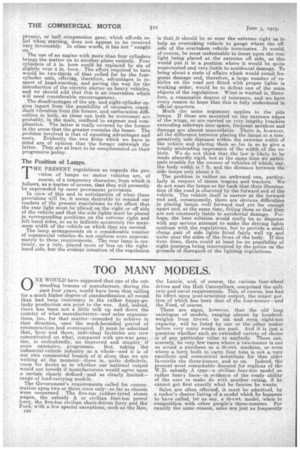The Position of Lamps.
Page 2

If you've noticed an error in this article please click here to report it so we can fix it.
THE PRESENT regulations as regards the provision of lamps on motor vehicles are, of course; of a temporary character, from which it follows, as a matter of course, that they will presently be superseded by more permanent provisions. In. view of this and in anticipation of what these provisions will be, it seems desirable to remind our readers of the present regulations to the effect that the rear light must be placed on the right or off side Of the vehicle and that the side lights must be placed in corresponding positions on the extreme right and left-hand sides, so as to indicate accurately the maximum width of the vehicle on which they are carried.
The lamp arrangements on a considerable number of commercial vehicles do not conform even approximately to these requirements. The rear lamp is certainly, as a rule, placed more or 'less on the righthand side, but the evident intention of the regulation
is thal,it should be so near the extreme right as to help an overtaking vehicle to gauge where the offside of theovertaken vehicle terminates. It would, of course, be most undesirable to insist 'upon the rear light being placed at the extreme off side' as this would put it in a position where it would be quite unprotected and very liable to accidental damage. To bring about a state of affairs which would entail frequent damage and, therefore, a large number of vehicles on the road not fitted with proper lights in working order, would be to defeat one of the main objects of the regulations. What is wanted is, therefore, a reasonable degree of tolerance, and we have every reason to hope that this is fully understood in official quarters.
Much the same argument applies to the side lamps. If these are mounted on the extreme edges of the wings, or are carried on very lengthy brackets extending sideways into space, frequent accident and damage are almost unavoidable. There is, however, all the difference between placing the lamps at a comparatively safe distance within the extreme width of
the vehicle and placing them soin as to give a totally misleading impression of he width of the vehicle. We do not think that the law is likely to be made absurdly rigid, but at the same time we anticipate trouble for 'the. owners of vehicles of which, say, the body width is 7 ft. and the distance between the side lamps only about 4 ft.
The problem is rather an awkward one, particularly in respect of steam wagons and tractors. We do not want the lamps so far back that their illumination of the roacleis obscured by the forward end of the vehicle. The vehicle itself is narrow at the forward end and, consequently, there are obvious difficulties in placing lamps well forward and yet far enough apart and, at the same time, fitting them so that they are not constantly liable to accidental damage. Perhaps, the best solution would really be to dispense with any serious attempt to make the driving lights confoem with the regulations, but to provide a small cheap pair of side lights fitted fairly well up -and quite near the sides of the front of the body. If this were done, there could at least be no possibility of night journeys being interrupted by the police on the grounds of disregard of the lighting regulations.






















